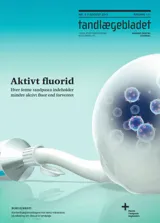Aktivt fluorid i fluortandpastaer på det danske marked
Maksimumsgrænsen for fluoridindholdet i tandpasta er underlagt lovgivningen, men der findes ingen eksakt regel for indholdet af aktivt (opløseligt) fluorid. Vi undersøgte, om fluortandpastaer i Danmark lever op til det deklarerede totalfluoridindhold, samt undersøgte, hvor meget opløseligt fluorid der findes i tandpastaer på købstidspunktet og efter simuleret ældning. 26 tandpastaer blev testet to gange, og koncentrationen af totalfluorid og opløseligt fluorid blev bestemt ved brug af en ionselektiv elektrode. Totalfluoridkoncentrationerne levede op til deklarationerne, én tandpasta afveg. 21 af tandpastaerne havde opløseligt fluorid lig totalfluorid; i de resterende fem udgjorde opløseligt fluorid 40-88 % af totalfluoridet. Opløseligt fluorid faldt i fire af de 26 tandpastaer under ældningssimuleringen og to af disse havde lavt niveau ved baseline. Når ældning var tilgodeset havde syv tandpastaer en lavere koncentration af opløseligt fluorid end totalfluorid. Seks af de syv tandpastaer med nedsat opløseligt fluorid indeholdt calciumholdige slibemidler. Derimod indeholdt de 19 tandpastaer, hvor opløseligt fluorid var ækvivalent med totalfluorid, ikke calciumholdige slibemidler. Fluorid i tandpasta reagerer med calciumholdige slibemidler eller andre tandpastakomponenter, og dette aspekt er der ikke taget højde for i lovgivningen. En stramning på området, der fastsætter krav til niveauet af opløseligt fluorid i fluortandpasta, vil kunne bidrage til at sikre den cariesforebyggende effekt.
Active fluoride in toothpastes in Denmark
The maximum content of fluoride in toothpastes is subject to regulations, but the soluble fluoride content is not defined. In this study we measured total fluoride of 26 toothpastes and compared the results with the declared fluoride concentrations. We also measured the concentrations of soluble fluoride at baseline and after simulated ageing. All measurements were performed in duplicate using an ion-selective electrode. With one exception, the total fluoride concentrations measured matched the labels. In 21 toothpastes soluble fluoride was equivalent to total fluoride content, and in the remaining five pastes soluble fluoride was 40-88 % of total fluoride. Simulated ageing reduced soluble fluoride in four of the 26 pastes and in two of these it was already low at baseline. Consequently, when the effect of aging was included seven of the 26 pastes had reduced active fluoride. Six of these seven pastes had calcium containing abrasives, whilst the 19 toothpastes with soluble fluoride equal to total fluoride did not contain abrasives with calcium. This study shows that fluoride in toothpaste reacts with abrasives containing calcium or other toothpaste ingredients resulting in reduced concentrations of active fluoride. The findings demonstrate that there is a need for revised regulations, defining minimum soluble fluoride concentrations in toothpastes.


